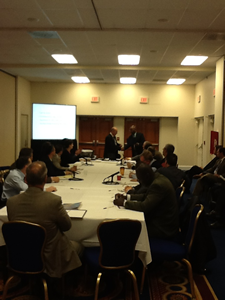Elizabeth Peggs, Geosynthetica’s Director, is in attendance at the 91st Transportation Research Board Meeting (TRB) in Washington, D.C. (along with nearly 12,000 others). As time permits, she is sharing some event updates here.
UPDATE, 8:00 am (EST), January 24
 |
Yesterday, Dr. Barry Christopher took over the chairmanship of the AFS70 Committee on Geosynthetics during the committee’s half-day morning meeting. The committee also discussed research needs, heard a presentation from Andrew Aho (Executive Director of the Geosynthetics Materials Association), further discussed on potential presentations for 2013 on “Incorporating Geosynthetics into the MechanisticEmpirical Pavement Design Guide” and “Instrumentation & Measurements of Geosynthetics in Highway Applications,” and offered a number of presentations for this year’s meeting. Topics included reinforced soil construction over sink holes, seismic response of geosynthetics in reinforced bridge abutments, frictional connection tests, and more on the FHWA’s geosynthetic reinforced soil – integrated bridge system (GRS-IBS) approach.
Today, the Soils and Rock Instrumentation Committee (AFS20) will address, among other items, instrumentation to evaluate soil-geosynthetic interaction (road foundations, reinforced earth). Barry Christopher will preside over "Measurements and Analysis of Geosynthetics in Walls and Pavement Applications, Part 1." That session will include presentations on effect of skewing and splaying on pullout capacity of steel MSE reinforcement, finite element analysis of geogrid reinforcement in flexible pavements, recycled asphalt pavements reinforced by geocells, geogrid-reinforced mechanically stabilized earth (MSE) walls. The Western Transportation Institute’s Eli Cuelho picks up the session in the afternoon to preside over “Measurements and Analysis of Geosynthetics in Walls and Pavement Applications, Part 2.” That session will include discussion of a full-scale evaluation of geogrid-reinforced thin flexible pavements, benefits of geosynthetics embedded in asphalt pavements, pullout behavior of nonextruded geogrids in base aggregate (laboratory investigation), and geogrid reinforcement in unbound granular pavement base bourses (laboratory investigation).
UPDATE, 3:16 pm (EST), January 23
Elizabeth Peggs reports that more than 4,000 papers are part of this year’s TRB–400+ more than last year, as far as papers are concerned. Of this staggering (and staggeringly diverse) volume, not all are included in the proceedings. By the initial count, the conference contains 11 papers specifically dedicated to geosynthetics, of which three are poster presentations. Only a few of the geosynthetics-dedicated papers will be in the proceedings (the rest reserved for sessions only), and two of those are actually poster presentations.
At such a large event, Elizabeth reports, the poster sessions have become very popular points for face-to-face dialogue and discussion of projects and engineering issues.
Among the geosynthetics-related subjects buzzing at the event is the Federal Highway Administration’s (FHWA) continuing promotion of the Geosynthetic-Reinforced Soil – Integrated Bridge System (GRS-IBS). As more DOTs and public works departments adopt the methodology, a larger body of accessible case studies and exemplary construction practices is developing and being rapidly shared and adopted.
UPDATE, 10:54 am (EST), January 23
 |
The annual Transportation Research Board (TRB) gathering in Washington, D.C. is underway. The Sunday evening opening reception in the massive exhibit hall was well-attended. The exhibit hall includes a large section for commercial exhibits as well as DOT- and government-related services.
For example, Ben Cotton (above, far left) with the US Department of Transportation’s Volpe National Transportation Systems Center talked to reception attendees about his team’s development of a tool and scoring system sustainable highway systems. This voluntary program is in beta testing with a late spring expected release of version 1.0. (Visit www.sustainablehighways.dot.gov for more information.) The Minnesota DOT is one of many state DOTs sharing knowledge in the hall. MnDOT has 18 studies in play at the moment, and 9 of them are expected to conclude this year. For northern roads research, these studies could offer significant support. Patrice Creel (above, right)from the US Army Corp of Engineers (USACE) is present too to talk to DOTs about ways USACE and DOT agenc can work together on project development.
Technial sessions have started up now. More updates will be shared soon from the event.











